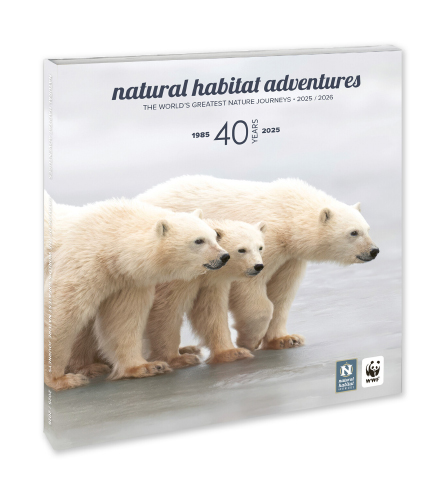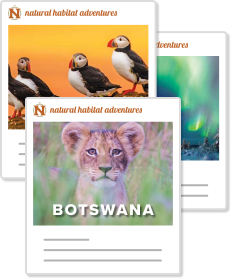Celebrating Women Who Tell Our Stories
March is Women’s History Month, a holiday designated by presidential proclamation to reflect on the often-overlooked contributions of women to United States history.
The National Women’s History Alliance, which spearheaded the National Women’s History Month movement, announced the 2023 theme, “Celebrating Women Who Tell Our Stories,” to honor women who have devoted their lives to “producing art, pursuing truth and reflecting the human condition.” Throughout the year, the NWHA will encourage recognition of women, past and present, who have been active across storytelling mediums such as print, radio, stage, screen, blogs and podcasts.
Finding My Calling
I was first called to the art and science of storytelling in 2007 at the age of 10 while on a Nat Hab expedition to see baby harp seals in the Gulf of St. Lawrence. (Similar to the trip that launched the company back in 1987!) The seal population was recovering from centuries of commercial hunting for oil and the fur trade, and the growing threat of climate change was sinking its formidable footprint into the Canadian landscape.
Here, in the Magdalen Islands, pregnant harp seals give birth on stable sea ice between late February and mid-March. Our helicopter touched down on an ice floe each day, and I would squeeze my sister’s hand in excitement. “Today is the day; I can feel it!” I squealed into the headset mic. Through the crackling feedback of the intercom, I could hear our Expedition Leader, Melissa Scott, hopeful but honest about our odds of making contact with the furry pups.

A photo I took of my younger sister as we lifted off the ground on our very first helicopter flight.
We never did reach the baby seals, as the ice was dangerously thin. I may not have returned home with rolls of animal photographs, but I did memorialize all the wisdom, compassion and moxie imprinted on me by Melissa. She taught me that regardless of how close you are to nature, you can still help save the planet by lending a voice to the animals and humans who have historically been silenced.
My explorations have since taken me to the top of Mt. Kilimanjaro, under the waves with Galapagos penguins, beneath rainforest canopies in Southeast Asia and across the plains of the Greater Yellowstone Ecosystem. With my journalistic voice and camera in hand, I aspire to empower girls and women to become lifelong advocates for endangered species and stewards of our planet.
Now, as one of many women who comprise this company, it’s a special privilege to introduce Nat Hab’s Women-Only adventure series, Women’s Journeys. I’ll share a glimpse of our newest itineraries and tell you the stories of women pioneers who embody the spirit of Conservation through Exploration.
Women’s Journeys
Women’s Journeys was born out of a desire to connect travelers with trailblazing women who have long been leaders in global exploration, entrepreneurship and science. Women from Africa to the Arctic carry the torch for protecting environments that sustain their families and endangered species like pangolins, wolves and polar bears. In addition to our conservation travel partnership with World Wildlife Fund, Nat Hab supports various philanthropic initiatives in our destinations, ensuring our activities benefit communities, safeguard wildlife and preserve cultural heritage.

Nat Hab & WWF travelers visit the Inuit Village of Tasiilaq during their East Greenland Arctic Adventure © Ralph Lee Hopkins
“We want to create a space for women who are ready for the next big adventure of their lives, where they can feel empowered to be themselves in some of the wildest places on the planet,” says Annie Van Dinther, veteran Expedition Leader and visionary designer of Nat Hab’s Women-Only Departures.

Louise Arnar Boyd was the first American woman to lead an Arctic expedition. She fearlessly discovered, mapped and documented uncharted territory in the far North, paving the way for future explorations and informing critical climate change research today. In 1955, Boyd chartered an airplane and became the first woman to fly over the North Pole. Before her death in 1972, she requested her ashes be scattered in the Arctic Ocean. Boyd’s legacy lives on through her photographs, which continue to inspire and inform people about the beauty and fragility of the Arctic region.
Women’s Journeys occupies a special place in the heart of Nat Hab Founder and President Ben Bressler, whose passion for ecotourism was sparked by his mother, Rozie. Rozie was a true force of nature—she spent her weekends in the 1960s and 70s championing civil rights and marching in Washington against the Vietnam War. In her pursuit of equality, Rozie became an attorney to help uplift the voices of women across the country.
Between caring for her family and studying for the Bar Exam, Rozie paged through dozens of travel books, planning her next great adventure. Cross-country road trips transformed into international escapades. She led her family from art and history museums in Japan and Spain to cultural immersion tours in Mexico.

Kingdom of the Monarchs © Court Whelan
“I’d like to share a newspaper story that would make my mom proud. It’s a first-person account of a group of intrepid women and their Nat Hab journey to the sub-arctic to see the northern lights,” Ben says. “If my mother were still alive, she would have understood the power of women joining together to explore the world and discover themselves. And she would have signed up for this trip in a heartbeat (if only to get away from my brother and me),” he adds.

© Eddy Savage
Women-Only Nature Trips
Women’s Journeys provides a unique opportunity to reflect on intimate discoveries in nature among the camaraderie of women from all walks of life. You’ll return home enriched by awe-inspiring wildlife encounters and with a new respect for the women who have been pivotal in understanding life on our planet. From the Canadian Arctic to Mexico’s monarchs, check out our slate of upcoming expeditions through a female lens!
Northern Lights & Arctic Exploration
Nat Hab’s first foray into trips for women, led by women, was on a 7-day Northern Lights & Arctic Exploration departure in February 2020 to view the northern lights above Churchill, Manitoba. “This trip is all about learning what it took for women to survive the Canadian Arctic. It’s about expanding our knowledge of natural history and science, and most importantly, it’s about discovering what we’re capable of alongside like-minded individuals. Put simply, it’s the trip the women Expedition Leaders of Nat Hab have always wanted to take themselves!” exclaims Van Dinther.

Nat Hab travelers on a Women’s Journey to see the northern lights © Judy Wilson
Recognizing Churchill’s history as an 18th-century fur-trading post—and as a place of human occupation dating back nearly 4,000 years—the trip brings to light life on the tundra through dog sledding excursions and traditional skills workshops, including sewing footwear, snowshoeing and igloo-building. Travelers meet women who run wilderness trap lines, conduct research at the Churchill Northern Studies Center and orchestrate modern-day Arctic expeditions.

© Eddy Savage
They visit with surviving Elders of the Sayisi Dene Nation and learn how they preserved their identity after the government forcibly relocated them from their home in Duck Lake, Manitoba, in the 1950s. The women also hear from Katie deMeulles as she regales the experiences and accomplishments of her late mother, Myrtle deMeulles, a respected Elder from the Manitoba Métis Federation. You’ll see examples of “Myrtle’s Caribou Hair Sculptures,” which celebrate Métis culture and illustrate the deep connection shared between Aboriginal people and Arctic animals.
“I taught about 60 other people how to do [tufting], and they are now passing that knowledge down to other people. Now, these people that I taught years ago have taught their daughters. You know, I stress the fact that it’s very important that we keep all these things alive and growing,” Myrtle shared with interviewer Marcy Markusa in 2015.

We Swim in the Same Waters – “Spirit in the water, spirit in the sky, spirit on the earth, all are connected. My piece is about ancestral legacy, what was passed on to us and what we will leave for our children’s children…” shared artist Charlie Johnston at the 2017 festival, Sea Walls: Murals for Oceans in Churchill, Manitoba.
Eager for more stories? Check out “15 Native Tales about the Northern Lights” on our blog Good Nature Travel! WWF guest writer Marsea Nelson describes how Indigenous peoples from the United States to Greenland and beyond perceive the mystical phenomenon of the aurora borealis.
Canada’s Premier Polar Bear Adventure
Our polar bear Expedition Leader is a consummate naturalist and outdoor explorer eager to share her knowledge of the North. She’ll teach you about Churchill’s cultural history and the iconic bear that reigns as Queen of the Arctic and serves as an indicator species for climate change. As you head out on the tundra in our Polar Rover in search of Arctic wildlife, rest assured that it’ll be a woman at the helm of our custom-designed monster truck, too!

© Court Whelan
As one of the first companies to operate adventures in Churchill more than 30 years ago, Nat Hab has become intimately acquainted with the local community. By operating sustainable expeditions for hundreds of visitors each year, we contribute financially to Churchill while using travel to raise our guests’ awareness and inspire their own conservation actions.

19th-century Inuit explorer Tookoolito, also known as Hannah and Taqulittuq. Born near Cumberland Sound on the east coast of Baffin Island, Tookoolito had a wanderlust like none other. As a teen, she traveled to England with her husband Ebierbing (Ipiirvik) and met Queen Victoria. Shortly after, the couple guided American explorer Charles Francis Hall throughout the Arctic for 10 years. Tookoolito also saved the USS Polaris’s surviving crew after being stranded for six months in 1872.
Nat Hab also contributes to WWF’s Arctic programs by increasing our scientific understanding of polar bear behavior, communicating the threat of diminishing sea ice and aiding communities in mitigating human-wildlife conflict in polar bear habitat.
Our goal is to go beyond showcasing nature to directly contribute to the well-being of Churchill and the surrounding environs that sustain its resident wildlife and people. Through years of developing close relationships, we are able to offer our travelers exclusive opportunities to meet revered Elders of First Nations, Inuit and Métis groups in Churchill. These storytellers are some of the most senior in their communities, passing traditional knowledge to younger generations and our travelers. Meet women who are the backbone of this historic Arctic settlement and see Canada through their eyes!

All of our Churchill polar bear tours include a personal visit with a local dog musher and their team and a ride through the boreal forest behind a team of sled dogs. © Court Whelan
Alaska Bear Camp
Following in the contrails of pilot and conservationist Celia Hunter, the adventurous women on our Alaska Bear Camp trip fly by private plane across Cook Inlet to our sustainable bush camp in Lake Clark National Park, a world-renowned bear-viewing destination. On the site of an old homestead, our camp fronts the bay in a pristine setting that looks just as it did when the first pioneers ventured into these remote wilds.

© Brad Josephs
During our trip, we learn about the role of women in Alaska exploration and conservation and get to know our Alaska Bear Camp manager, Caprice Stoner, who has passionately guided operations here for more than 17 years.

In addition to managing the daily operations of Bear Camp, every year, Caprice (pictured left) seeks to improve her knowledge and training as a naturalist and adventure travel professional through new experiences and additional guide certifications. She has also worked as a hiking, cycling and kayaking guide and has an extensive background in interpretation of natural and cultural history. In recent years, as bear viewing in the Chinitna Bay region of Lake Clark National Park has become much more popular, Caprice has worked with the park service to create consistent rules and practices for respectful, low-impact bear observation. Watch this video of Caprice to see her passion in action! © Court Whelan
Each of our deluxe tent cabins is named after a person of historical significance. We proudly honor women like Celia Hunter, who protected the Pacific Northwest from Project Chariot’s nuclear warhead blasts and the Yukon River from the massive Rampart Dam. She also founded the Alaska Conservation Foundation and was the first female president of The Wilderness Society.

Celia Hunter at Camp Denali Alaska in August 1957. © Kit Case
You’ll see the name “Margaret,” endearingly referred to as the “Grandmother of the Conservation Movement,” who in 1924 became the first woman to graduate from the University of Alaska. In a congressional testimony about the Alaska Lands Act Mardy famously stated:
“I am testifying as an emotional woman and I would like to ask you, gentlemen, what’s wrong with emotion? Beauty is a resource in and of itself. Alaska must be allowed to be Alaska, that is her greatest economy. I hope the United States of America is not so rich that she can afford to let these wildernesses pass by, or so poor she cannot afford to keep them.”
You’ll also hear the heroic tale of Ada Delutuk Blackjack, an Iñupiat seamstress turned Indigenous interpreter, hunter and survivalist for the ill-fated Arctic expedition led by Vilhjalmur Stefansson to settle Wrangel Island in 1921.

Ada Blackjack
Iceland: Circling the Land of Fire & Ice
Consistently cited as one of the best places in the world to be a woman, the nation of Iceland beckons female-empowered exploration. Take it from Viking Gudrid Thorbjarnardóttir—better known as “The Far Traveler.” As her nickname suggests, Gudrid ventured to Norway and Greenland and even made a pilgrimage to Rome. Her greatest exploit, however, was sailing across the Atlantic to the Americas some 500 years before Christopher Columbus stepped foot in The New World.
Gudrid’s adventures are immortalized in 13th-century Icelandic texts called the Vinland Sagas. According to the Saga of the Greenlanders (Grænlendinga Saga) and the Saga of Eric the Red (Eiríks Saga Rauða), she lived in North America (known to the Vikings as “Vinland”) for three years and had a son named Snorri, who was the first European to be born there.

© Court Whelan
Inspired by Gudrid’s spirit for adventure, our travelers make a complete circle around Iceland by private mini bus, chartered plane, boat and 4×4 Super Jeep. Led by our seasoned Expedition Leader and a local guide, our all-women fleet will witness whales in the far-flung Westfjords, see soaring Atlantic puffins and hike from volcanic fields to glacial precipices.

© Heather Chrystie
Here, where the North American and Eurasian plates collide, geothermal forces create a dynamic and dramatic landscape—an experience of pure nature at its most powerful, matched only by the grit of the women who walk the country’s black sands.

© Court Whelan
Mexico: Kingdom of the Monarchs
Journey into the highlands of Central Mexico on our Kingdom of the Monarchs adventure with two female Expedition Leaders eager to share their passion for this region’s natural and cultural heritage. Witness millions of monarch butterflies gathering at their winter roosting sites in Mexico’s forested highlands, and learn how the female monarchs—each of which lays between 300-500 eggs—help maintain an insect population that undertakes an incredible 3,000-mile annual migration from the northern U.S. and Canada to Mexico.

© Court Whelan
Our guides share the stories of the many women who have enriched our knowledge of the monarch migration. Listen to the adventures of Mexico-born Catalina Trail (then known as Cathy Aguado), the woman featured on the cover of National Geographic in August 1976, who helped discover the butterflies’ winter roosting site.

Riding small Mexican horses provided by the local community (and led by your own caballero, so no prior horseback experience is necessary), we ascend the trail through the forest as hummingbirds and red warblers accompany us to the heart of the monarchs’ migration site. © Daniel Hagaman

Catalina Trail captured in her element for the Nat Geo cover story “Discovered: the Monarchs’ Mexican Haven.” Check out this enlightening interview between Catalina and journalist Monika Maeckle from 2012!
Learn about environmental education efforts in the U.S. and the long-term health of monarch populations from entomologist Karen Oberhauser. Meet women from the small rural community of Angangueo, whose families have experienced the monarch migration for generations, and see how traveling with Nat Hab & WWF supports the local economy.

© Court Whelan
You’ll return home not just awed by the monarch migration but also inspired by the many women whose heroic efforts have preserved Mexico’s butterfly sanctuaries and protected North America’s monarch populations.



























